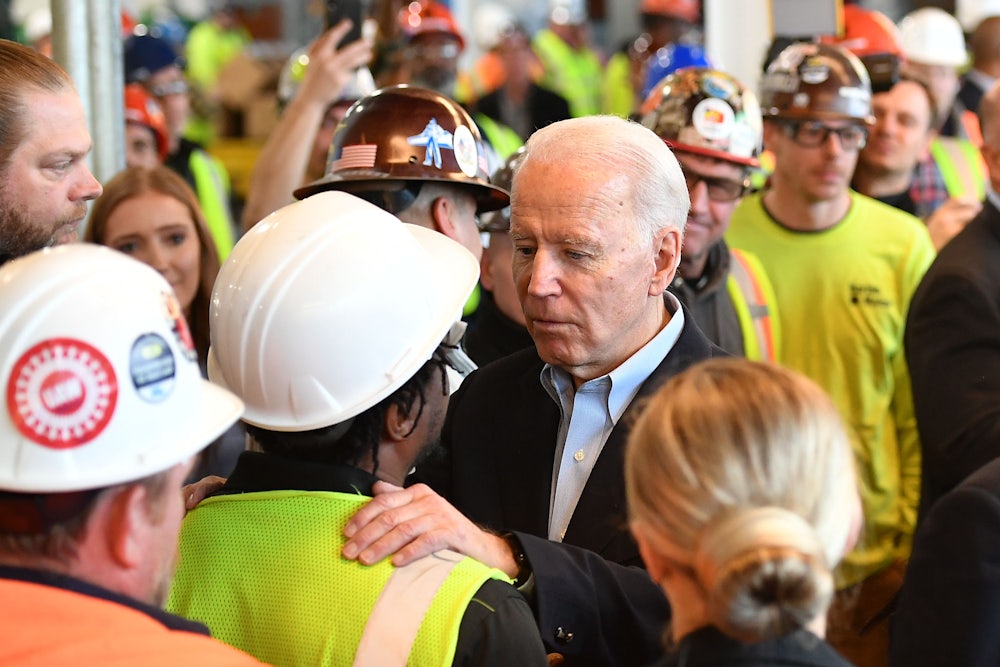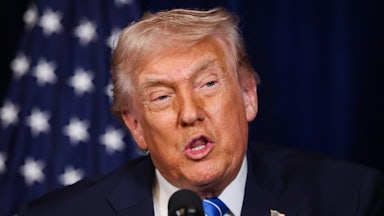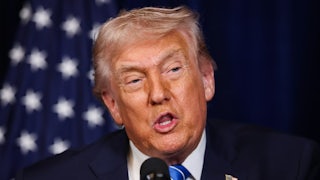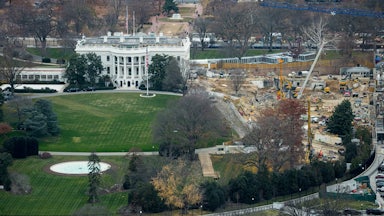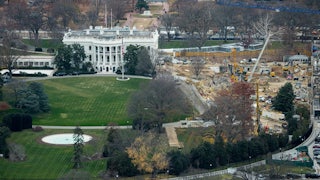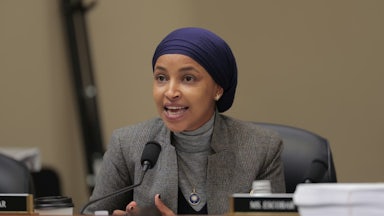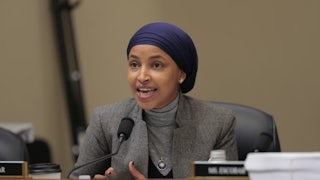At a moment when Democrats and Republicans vie for the working-class vote, a new report from the U.S. Chamber of Commerce denouncing the Biden administration’s “whole of government” support for labor unions is admirably clarifying. You’ll hear the Chamber make the same complaint about the GOP when chickens grow teeth.
There was a time when the Chamber accepted labor unions as a fact of life. “Labor unions are woven into our economic pattern of American life, and collective bargaining is part of the democratic process,” Chamber of Commerce President Eric Johnson said at a labor-management summit called by President Harry Truman in 1945. “I say [let’s] recognize this fact not only with our lips but with our hearts.” It may surprise you to learn that Johnson’s wife and children were not wired with explosives while he uttered these words.
That did not remain the Chamber’s position. “Unions are not the answer to increasing prosperity for American workers or the economy,” it said in a 2008 paper. Since then, the Chamber has softened its rhetoric, in keeping with the conservative trend of rephrasing unpopular positions in the language of pluralism. Now the Chamber says workers should be given the right to choose whether to organize—while it lobbies furiously to rig the game against workers choosing unionization.
Here’s how the Chamber, in its new report, articulates its view of labor unions:
The cornerstone of U.S. labor law is the right of employees to make their own decisions about unions. Indeed, the law does not (and should not) dictate the choice of unionization for employees; instead, it is up to each employee to make that decision for themselves.
That sounds perfectly fair, but it’s also perfectly wrong, and the Chamber knows it. The cornerstone of U.S. labor law is the 1935 National Labor Relations Act, or NLRA, which says in its preamble that the statute’s intention is to promote collective bargaining:
It is declared to be the policy of the United States to eliminate the causes of certain substantial obstructions to the free flow of commerce and to mitigate and eliminate these obstructions when they have occurred by encouraging [italics mine] the practice and procedure of collective bargaining.
The Chamber backs up its interpretation of the NLRA by citing First National Maintenance Corp. v. NLRB, a 1981 Supreme Court decision that said the NLRA “is not intended to serve either party’s individual interest.” This is willfully dishonest. The “individual interest” referred to in First National Maintenance was not whether to organize a workplace or not; the company in this lawsuit, a housecleaning service, was already unionized. The case turned on whether the company was obliged to bargain with its union over closing down part of its business; the court ruled it was not.
The Chamber would have you believe that the NLRA says: “Organize or don’t organize, we don’t give a damn.” Wrong. The NLRA says: “We’d like to help you organize.” Workers can still, of course, choose not to unionize, but the U.S. government doesn’t feign indifference to that choice any more than it feigns indifference to a citizen not voting in a national election. Uncle Sam won’t punish you for sitting out a presidential or congressional contest, but he really prefers that you vote, because that bolsters the legitimacy of representative democracy. Choose whichever candidate, or whichever labor union, you want, Uncle Sam says, but please do choose one. I know that sounds radical, but that’s what the NLRA says, and Joe Biden is the first president in my lifetime to honor the preamble explicitly.
The Chamber caricatures the Biden administration’s stance as a “unions-at-all-costs approach,” but if you ignore that, the report is a handy guide to the various ways in which Biden respects the intent of the NLRA as no president has since Harry Truman. Some of what the Chamber brings up isn’t terribly significant, in my view, at least with respect to organized labor, but a lot of it is. I learned from this report that Biden’s actually done quite a bit more for unions than I knew.
Here’s a sampling:
Executive orders. “Most notably, the White House … has formed a multiagency Task Force on Worker Organizing and Empowerment.” I would dispute “most notably.” The task force was headed by a disappointing labor secretary, Marty Walsh, and a disappointing vice-president, Kamala Harris, and although there’s nothing particularly wrong with the recommendations it came up with—among them, that the General Services Administration “facilitate training or listening sessions for federal contractors’ employees about the benefits of collective bargaining”—these are recommendations, not actions. The Chamber’s report deems such recommendations so obviously unspeakable that it doesn’t even bother to argue against them; merely describing them, it seems to feel, is sufficient. (That’s the Chamber’s approach throughout much of this report.) Much more significant than the task force executive order, I think, was Biden’s executive order issued one day earlier, which required federal contractors to pay workers a $15 hourly minimum. (The Chamber report mentions that too.)
Antitrust Actions. “To promote the union agenda.” Labor unions support a more aggressive antitrust policy to combat monopsony (i.e., lowered wages) of the type I described earlier this month at Amazon warehouses. But it’s a stretch to call antitrust a labor-driven issue; the Chamber brings it up merely because it hates the current revival of antitrust. The Chamber cites mention of a possible Federal Trade Commission ban on noncompete clauses in an executive order on competition that Biden issued in July 2021. But you don’t need an antitrust lawsuit to fix that. According to Franklin Foer’s 2023 Biden book, The Last Politician, White House Deputy Chief of Staff Bruce Reed slipped in the noncompete ban because he knew Biden was pissed off that the Jimmy John’s sandwich chain required food workers to sign noncompete clauses; eventually the New York state attorney general made it stop. In January the FTC proposed a rule banning noncompete clauses.
The National Labor Relations Board. The Chamber doesn’t care for NLRB General Counsel Jennifer Abruzzo, for pretty much the same reasons that I praised her in an April 2022 piece, so I won’t rehash those. I found it extremely useful to learn which NLRB decisions irk the Chamber the most. These are:
Cemex, which empowers the board to compel management to recognize a labor union if management misbehaves during an organizing drive;
Stericycle, which held that a work rule is presumptively unlawful if it can be interpreted to restrict worker rights;
Bexar II, which enables contract employees to protest at a worksite owned not by the contractor but by the company that contracted out the work (which is more likely known to the public and therefore more vulnerable to bad publicity);
American Steel Construction, which makes it easier for workers to organize, as a single bargaining unit, part of a workplace rather than the whole thing;
McLaren Macomb, which outlawed severance agreements with broadly worded non-disparagement provisions;
Lion Elastomers LLC II, which made it harder to fire an employee for speaking rudely or abusively if it’s connected to a protest against working conditions;
The Atlanta Opera, which made it harder for employers to misclassify people who meet the legal definition of an employee as an independent contractor, thereby denying that employee various benefits required under law. (The Chamber report mentions a proposed NLRB regulation defining “employment” more broadly in cases where workers are misclassified as independent contractors. That rule was finalized on Thursday.)*
These are, by the Chamber’s lights, the NLRB’s most important decisions under Biden, which makes this list extremely valuable to union symps like me who are trying to figure out what matters.
The Chamber is also irked by the Labor Department’s Worker Organizing Resource and Knowledge Center, which frankly I thought too boring to write about. I may now have to reconsider. The Chamber complains that “most of the pro-union studies and reports prominently featured and cited on the WORK website were produced by the Economic Policy Institute, whose board of directors is currently chaired by the president of the AFL-CIO,” i.e., Liz Shuler. I’m glad the Chamber brought this up. I, too, wish the EPI weren’t so very dominant on research related to workers. There ought to be more excellent Washington-based nonprofits producing a comparable quantity of first-rate studies on such matters. Given labor issues’ centrality to the Democratic Party agenda (or anyway what’s supposed to be the Democratic Party agenda), it’s kind of a scandal that there aren’t. I will, however, put in a good word for the National Employment Law Project.
I could go on. The Chamber’s report is packed with evidence that the Biden administration is doing more for labor than you knew (or anyway, than I knew). It will be an invaluable resource going forward. I thank the Chamber for the hard work it obviously put in, and I fully expect the Biden administration to issue a press release soon that cribs heavily from it.
* This article has been updated.
